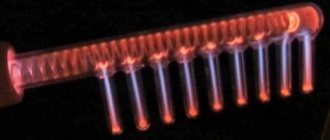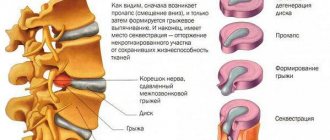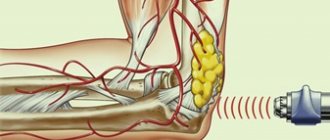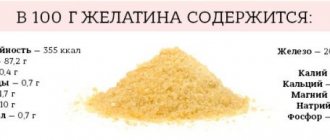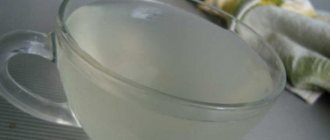Pharmacological properties of the drug Diclofenac
NSAID, a derivative of phenylacetic acid with pronounced anti-inflammatory, analgesic and antipyretic activity. The pharmacological properties of diclofenac are due to its ability to inhibit the biosynthesis of certain prostaglandins as a result of inhibition of the enzyme prostaglandin synthetase. By blocking the synthesis of prostaglandins, diclofenac eliminates or significantly reduces the severity of symptoms of inflammation. Diclofenac reduces the increased sensitivity of nerve endings to mechanical stimuli and biologically active substances produced at the site of inflammation, induced by prostaglandins; leads to a decrease in body temperature, preventing the effect of prostaglandins on the hypothalamic link of the thermoregulation process; reduces the concentration of prostaglandins in menstrual blood and the intensity of pain during primary dysmenorrhea. The use of diclofenac helps to increase the range of motion in the affected joints, reduce pain at rest and during movement. In vitro , diclofenac at a concentration equivalent to that achieved in human tissue during treatment does not inhibit the biosynthesis of cartilage tissue proteoglycans. Inhibits platelet aggregation. Diclofenac is quickly and completely absorbed from the digestive tract. The maximum concentration in the blood after taking diclofenac orally in tablet form is achieved within 20–60 minutes. Eating at the same time slightly slows down the rate, but not the volume, of absorption. Considering that about 50% of diclofenac is metabolized during the first passage through the liver, the AUC when diclofenac is taken orally or used in the form of rectal suppositories is almost 2 times less than in the case of parenteral administration of an equivalent dose. After repeated administration of diclofenac, the pharmacokinetic parameters do not change. Almost 99.7% of diclofenac binds to serum proteins (mainly albumin). The apparent volume of distribution is 0.12–0.17 l/kg body weight. Diclofenac penetrates into the synovial fluid, where its maximum concentration is reached 2–4 hours later than in the blood plasma. The apparent half-life from synovial fluid is 3–6 hours. 2 hours after reaching the maximum concentration in the blood plasma, the concentration of diclofenac in the synovial fluid remains higher; this pattern persists for approximately 12 hours. Biotransformation of diclofenac occurs partly by glucuronidation of the unchanged molecule, but mainly through single and multiple methoxylation, which leads to the formation of several phenolic metabolites (3′-hydroxy-, 4′-hydroxy-, 5′- hydroxy-, 4′,5-dihydroxy- and 3′-hydroxy-4′-methoxydiclofenac), most of which are conjugated with glucuronic acid. Two of them are pharmacologically active, but to a much lesser extent than diclofenac. The total systemic clearance of diclofenac from blood plasma is 263 ± 56 ml/min, the final half-life from blood plasma is 1–2 hours. The half-life of 4 metabolites, including two pharmacologically active ones, is also short and amounts to 1–3 hours. One of the metabolites is 3-hydroxy-4-methoxydiclofenac - has a longer half-life, but this metabolite is pharmacologically inactive. About 60% of administered diclofenac is excreted in the urine in the form of glucuronic conjugates of the intact molecule of the active substance and in the form of metabolites, most of which are also converted into glucuronic conjugates. Less than 1% of diclofenac is excreted unchanged. The rest of the administered dose is excreted as metabolites in bile and feces. There are no significant changes in the pharmacokinetics of diclofenac in elderly people, patients with kidney disease, chronic hepatitis or compensated cirrhosis.
About blockades
Diclofenac is also widely used for paravertebral blockades, when it is injected directly into the deep muscles of the back. In addition to diclofenac, there may be glucocorticosteroid hormones, chondroprotectors, hyaluronic acid substitutes, and almost always a local anesthetic, for example, Lidocaine, is administered along with them. Such a therapeutic blockade breaks the pathological circle between spasm and pain, and the patient, who was brought to the hospital on a gurney, can, after installing the blockade, slowly go home on his own feet.
However, despite the rapid elimination of pain and inflammation, the blockade is not a radical cure, and blockades are indicated just in the first days of an exacerbation in the presence of protrusion and especially a hernia, with significant severity of persistent pain. If all means of treatment have ceased to help the patient, and only blockades help, then this is a sure sign that the patient already needs neurosurgical intervention or surgery.
Indications for use of the drug Diclofenac
Rheumatism, rheumatoid arthritis, osteoarthritis, ankylosing spondylitis, gout, lumbago, neuralgia, myalgia, pain due to traumatic injuries of the musculoskeletal system and soft tissues, primary dysmenorrhea, as a symptomatic remedy for infectious and inflammatory diseases of the ENT organs. In ophthalmology: inhibition of miosis during cataract surgery; prevention of the inflammatory process in the postoperative period for cataracts and surgical interventions in the anterior parts of the eye; prevention of cystoid macular edema before and after operations for lens removal and implantation; non-infectious inflammatory processes involving the anterior parts of the eye (chronic non-infectious conjunctivitis, allergic conjunctivitis); post-traumatic inflammatory process with penetrating and non-penetrating wounds of the eyeball (as an addition to local antibacterial therapy); to reduce the severity of eye pain in photophobia.
Features of use: contraindications and side effects
The following conditions are contraindications to the use of both Diclofenac and Diclac:
- pregnancy and breastfeeding
- age under 6 years
- allergic reaction to acetylsalicylic acid
- stomach or duodenal ulcer
- hypersensitivity to the components of the drug
- exacerbation of inflammatory bowel diseases
- change in blood composition
Exceeding the dosage and duration of treatment may lead to side effects. Therefore, the use of Diclac or Diclofenac is possible only after the attending physician carefully examines the medical history, assesses the possible risks and prescribes one of these medications.
The reaction to the drug can be both systemic and local in nature. In the first case, urticaria, angioedema or a bronchospastic reaction may develop. The occurrence of a generalized skin rash cannot be ruled out. Local reaction has such manifestations as:
- contact dermatitis
- eczema
- swelling at the application site
- skin redness
- peeling and itching
- photosensitivity
The main difference between Diclac and Diclofenac is their manufacturer. The first drug is of Swiss origin and is produced by the pharmaceutical company Sandoz. Diclofenac can be found in pharmacies of both domestic and imported origin. Their prices also differ: Diclak gel costs about 260 rubles, diclofenac, depending on the manufacturer, from 30 to 120 rubles.
Use of the drug Diclofenac
Orally, adults and adolescents over 14 years of age are prescribed 50–75 mg 2–3 times a day or 25 mg 4 times a day for acute conditions; for chronic diseases and for maintenance therapy - 25 mg 2-3 times a day or in retard form (100 mg) 1 time a day. The duration of treatment is 5–6 weeks. The maximum daily dose is 300 mg. Also used rectally. 75 mg is administered intramuscularly (deep into the gluteal muscle) 1–2 times a day. It is not recommended to prescribe a long course of injections (more than 4–5 days). For the symptomatic treatment of primary dysmenorrhea, the dose of diclofenac can be 50–200 mg/day. The duration of treatment is determined by its effectiveness and usually does not exceed 2–3 days. The gel is applied in a thin layer to painful areas 2-3 times a day. The duration of treatment is 10–14 days. Eye drops 0.1%: before surgery - 1 drop into the conjunctival sac 5 times within 3 hours before surgery; in the postoperative period - immediately after surgery - 1 drop 3 times (at 15, 30 and 45 minutes after surgery), and then - 1 drop 3-5 times a day for the time required for treatment; to eliminate pain - 1 drop immediately after surgery, then - 1 drop 4-6 times a day, if necessary for up to 6 days; for inflammatory processes - 1 drop 4-5 times a day, depending on the severity of the condition. Long-term treatment should be carried out only after a thorough assessment of the indications and ophthalmological examination. As a rule, use no more than 1–2 weeks.
Composition and release form
As mentioned above, diclofenac is used to relieve inflammation, and this is a nonspecific process; inflammation can be anywhere. Therefore, diclofenac probably has the largest possible number of different dosage forms, even eye drops. However, to relieve acute back pain, diclofenac is first used in the form of intramuscular injections, then it is possible to switch to tablets, also for 2-3 days, and then gels or ointments containing diclofenac can be prescribed and rubbed into the projection of the greatest area of pain in lower back.
Rectal suppositories can also be purchased at pharmacies, which can be used if the patient cannot swallow or has nausea and vomiting. As for tablet drugs, nowadays you can most often buy the enteric form of Voltaren, which, bypassing the stomach, releases the active substance in the intestines.
There are two dosages (25 and 50 mg). These tablets are packaged in packs of 20 pieces, and the cost of packaging the maximum dosage, on average, ranges from 260 to 320 rubles. This price is valid for pharmacies of all forms of ownership for the month of July 2019 in the Russian Federation.
As for Voltaren in ampoule form, in a solution for intramuscular administration, it is packaged in ampoules of 3 milliliters with a concentration of 2.5%. One package contains 5 ampoules. Such a small package is made in order to prevent frequent injections, as is usually implied, for example, for vitamins that come in packages of 10 or even 20 ampoules. In the case of diclofenac, the shorter the course, the better. The cost of Voltaren in ampoules is, on average, from 190 to 270 rubles per package.
Side effects of the drug Diclofenac
pain in the epigastric region, nausea, vomiting, diarrhea, ulcerogenic effect, gastrointestinal bleeding, intestinal perforation, exacerbation of ulcerative colitis, headache, loss of consciousness, dizziness, sensory or visual impairment (diplopia), tinnitus, insomnia, irritability, seizures, acute renal failure, interstitial nephritis, nephrotic syndrome. Nephropathy occurs in most cases as a result of very long-term use of diclofenac. It is possible to develop allergic reactions, including cross reactions, to other NSAIDs. Long-term use of diclofenac can cause the development of a hypertensive crisis due to inhibition of prostaglandin biosynthesis in the kidneys. Very rarely, hemolytic anemia and hematopoietic disorders (thrombocytopenia, leukopenia, agranulocytosis, aplastic anemia) are observed; sometimes - liver damage. When using eye drops, a transient mild or moderate burning sensation may occur; rarely - blurred vision immediately after instillation of eye drops, hypersensitivity reactions accompanied by itching and hyperemia, photophobia, punctate keratitis.
Indications and use for spinal hernia
We remind you that in case of acute pain in the back and especially often in the lumbar region, it is logical to begin treatment on the first and second days with intramuscular administration of diclofenac, of course with all precautions. Typically, in patients whose acute back pain causes a significant decrease in quality of life and has appeared quite recently, just yesterday or today, one intramuscular injection daily for two to three days is sufficient.
Perhaps, to prevent its ulcerogenic or ulcer-forming effect, the patient can be given Omeprazole, which is a proton pump blocker and is used in gastroenterology as a drug that reduces the acidity of gastric juice. The thing is that during treatment with diclofenac, the mucous membrane of the stomach and duodenum becomes more vulnerable to damaging factors, including spicy and sour foods. This can trigger the process of ulcer formation, so it is advisable to “cover up” with Omeprazole, even if there is no exacerbation of gastritis at the moment. Then you should switch to taking the drug in tablet form. The initial daily dose is no more than 150 milligrams, and is taken approximately one tablet three times a day. Then, as the pain decreases, the patient is transferred to local treatment (Voltaren-emulgel).
Special instructions for the use of Diclofenac
Prescribed with caution to persons with dyspeptic symptoms, diseases of the digestive tract, hypertension (arterial hypertension) or circulatory failure, renal failure, as well as patients who have recently undergone surgery. Throughout the course of treatment, it is recommended to monitor renal and liver function. When taking diclofenac for a long time, you should refrain from driving vehicles and performing potentially dangerous activities that require increased attention and speed of reactions. Taking diclofenac during pregnancy is contraindicated. During breastfeeding, it can be prescribed only according to strict indications and under close medical supervision.
Diclofenac or surgery?
The following can be briefly said about operations. Currently, in developed countries of Western Europe, the USA, and Israel, modern minimally invasive neurosurgical intervention for protrusions and hernias is already close to the effectiveness, safety and mobility of an outpatient dental appointment. Almost always, the patient can go home on his own feet the same day or the next day after the operation, he is immediately allowed to sit, and the operation itself does not at all seem like something terrible and bloody, but simply a small and painless type of treatment.
Even in many countries of Eastern Europe, for example in the Czech Republic, neurosurgeons achieve very high results in the treatment of protrusions and hernias, and other complications of osteochondrosis if there are indications for surgery. Patients do not need to wait unsuccessfully for years, and during an exacerbation, spend a lot of money on medications, massages, chiropractors, kinesiotherapists and other specialists.
The only radical way to treat hernias and protrusions at present is modern minimally invasive neurosurgical surgery. Therefore, if only diclofenac in large doses, and especially in blockades, helps a patient with hernias, then this is a vicious path. It can cause serious complications, which will be discussed below.
Drug interactions Diclofenac
It should not be used simultaneously with other NSAIDs (including salicylates and pyrazolone drugs), since with such a combination there is a risk of mutual potentiation of toxic effects and a decrease in the effectiveness of one of the drugs. When used simultaneously with anticoagulants, the risk of developing hemorrhagic complications increases significantly. When combined with lithium salts, diclofenac may increase the concentration of lithium in the blood plasma. Co-administration of digoxin with diclofenac after 48–72 hours can lead to a significant increase in the concentration of the glycoside in the blood plasma; after stopping taking diclofenac, digoxin levels return to normal after 48 hours. Diclofenac causes sodium and fluid retention in the body, reducing the effectiveness of antihypertensive and diuretic drugs. When combined with diuretics, potassium levels should be monitored. It is not advisable to prescribe simultaneously with cyclosporines. GCS may potentiate the toxic effects of diclofenac. For patients taking methotrexate, diclofenac is prescribed 24 hours before or after taking methotrexate, since the plasma concentration and toxicity of the latter may increase.

